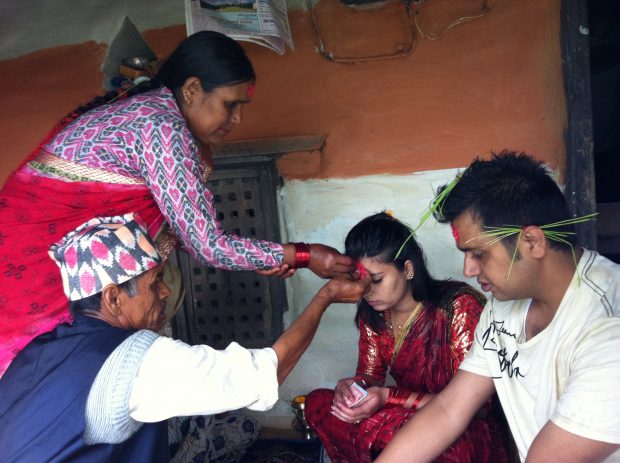네팔 최대 명절 ‘다샤인’을 아십니까?

[아시아엔=비시누 고탐 <라이징 네팔> 편집장] 네팔의 전통 다샤인은 힌두교 축제로서 네팔민족 최대의 명절이다. 15일의 명절기간 중 첫 9일은 여신 두르가의 아홉 가지 이름을 부르며 예배를 드린다. 10일째는 비자야다샤미라고 불리며 이날 축제분위기는 최고조를 이룬다. 이날을 시작으로 남은 5일간 사람들은 친척과 이웃들을 방문하며 어르신들에게 티카를 드리고 덕담을 듣는다. 10월의 보름달은 명절의 끝을 알린다. 명절기간 동안 150만명 가까운 시민들은 카트만두를 떠나 고향으로 돌아간다. 보너스로 두둑해진 주머니로 선물과 고기를 사서 네팔인들은 축제를 즐긴다. 학교는 15일 내내 쉬지만 직장인들은 5일 정도밖에 휴일이 없기에 보름달도 보지 못하고 카트만두로 되돌아가야 한다. <요약 및 번역 윤석희 <아시아엔> 미국 특파원>
아래는 영어로 된 전문입니다.
Much Fanfare Marks Dashain, Nepal’s Festival of Unity
written by Bishnu Prasad Gautam, Editor, Rising Nepal
Ambika Khanal, an account officer of Nepal’s civil service, reached Ilam, his home village located some 600km east from Kathmandu, the capital city, with his wife and 19-month old daughter on October 6. He had reserved a van for Rs.19,000(roughly USD 190) for the trip with three other couples with children. They were returning home to mark Dashain, the greatest festival of the Nepalese people that is usually in October.
Dashain, a Hindu festival, marks a 15 day holiday across Nepal. Everyone living or working away from their parental homes return to the villages to celebrate this festival with their family members. Ambika Khanal is one such man.
“I hired this van this time as it is not easy to travel by bus in the long route with kids,” he said while getting off the vehicle carrying his small daughter. He was smiling in anticipation of returning home.
“We have to trek for two more hours to reach our home from here,” he said and moved westward. His wife followed her.
He did not come home last year due to the Indian blockade and disturbances in the southern plain over which the highway linking Kathmandu and his home district passes.
Though the journey was tiresome, smileslurked in the lips of their faces as they were united with their family members for the festival.
Nearly 1.5 million people left Kathmandu for their villages, said police.
Many migrant Nepalese workers returned home to mark the festival. Yam Acharya was one of several migrant workers who returned to Ilam from Qatar on October 8.
“After two years, I have come home for Dashain,” he said.
Schools and colleges remain closed for 15 days, and offices are closed for 5 days during Dashain. Most government employees and those working in the private sector return to their villages to mark this festival.
Even those who live in Kathmandu go to villages to see their parents and elder brothers. Receiving tika(a mark on the forehead from a rice seed mixed with red dye and yoghurt) and blessings from seniors are the main practice of this festival. Some ethnic communities use white instead of red for the tika.
The festival has two parts?the Goddess Durga(who symbolizes power) is worshipped with nine different names for the first nine days. In the remaining six days the tika (prasad of the worship) is offered or received. With the red or white mark on the forehead, jamara(yellow seedlings of maize, paddy, barley) is also offered. Jamara is grown in the room where the goddesses were worshiped for nine days.
The festival begins by sowing the seeds to grow the jamara. This day, called Ghatasthapana, is also a holiday.
While offering worship to the goddesses, people clean their houses, buy foods, he-goats, buffaloes and pigs to prepare a feast. They buy new clothes, which is customary when receiving or offering tika.
The buffaloes, symbol of demons, are butchered on the seventh day, he-goats on the eighth day, and pigs on the ninth day. The bloods of these animals are offered to the goddesses and the flesh is eaten. The largest number of buffaloes and goats are offered at the temple of Taleju Bhawani at Durbar square, Kathmandu.
This temple, which survived the powerful earthquake of 2015, is open to the public once a year on the ninth day of Dashain, which is known as Maha Nawami. Altogether 54 male buffaloes and 54 male goats are sacrificed at this temple during Dashain.
Kathmandu is almost deserted during the festival period, but business is brisk across Nepal during this festival. People often choose to buy different gadgets during this festival. Employees are usually paid extra for this festival.
The tenth day is called Vijaya Dashami, the main day of the 15-day festival. This year it fell on October 11. On this day, people first receive tika and jamara from their grandparents or parents at home. Later, they visit their relatives, in-laws, brothers and uncles and aunts and receive tika from them. This process continues for five days. The Dashain finally comes to an end on the full moon day.
Of late, Nepalese communities living in America, Europe, and Australia also mark this festival as their numbers increase in these countries.
The employees and others who have been to their homes start returning to working places before the festival ends.
“Almost 62,000 people returned to Kathmandu today,” police at the Thankot entry point said on October 14, the 13th day of Dashain.
Ambika Khanal was among those who returned to Kathmandu. This year, rains in eastern parts of the country spoiled Dashain for many revellers. The locals could not erect and enjoy swings due to constant rains. Erecting swings is a popular practice of Dashain. Everyone enjoys the swings at least once on the day of Vijaya Dashami.





